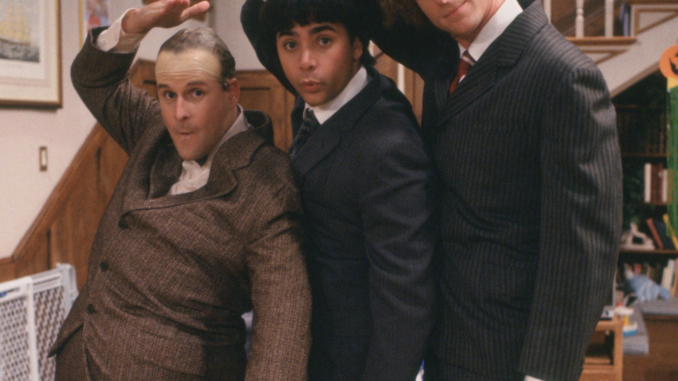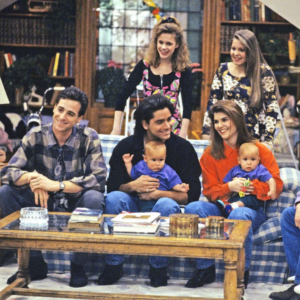
The late 1980s gave rise to a handful of TV shows that would go on to shape television as we know it. Among those iconic titles, Full House stands out as one of the most enduring and beloved family sitcoms of all time. Premiering in 1987, Full House became a cultural phenomenon that still resonates with audiences today, decades after it first aired. This article takes a closer look at why Full House (1987) remains so beloved, the secret to its lasting success, and how it has influenced generations of viewers.
The Heartwarming Premise of Full House (1987)
At the core of Full House lies a simple yet universal premise: a widowed father raising his three daughters with the help of his two quirky friends. Danny Tanner, played by Bob Saget, is a single dad who’s doing his best to raise his daughters in a world that feels a little bit more complicated after the death of his wife. Enter the two characters who would help him along the way: Uncle Jesse (John Stamos), the cool, rock-and-roll-loving bachelor, and Joey (Dave Coulier), a goofy, yet lovable stand-up comedian.
This unusual family dynamic became the heart of the show. With its blend of humor and heartfelt moments, Full House became a perfect example of a family sitcom that could tackle serious themes without losing its lighthearted charm.
The Cast That Became Family
When it comes to TV shows that leave a lasting impact, the cast plays a crucial role in making that connection with audiences. In the case of Full House, the cast was a dream team of talented actors who each brought something unique to the table.
Bob Saget (Danny Tanner): Bob Saget’s portrayal of Danny Tanner was equal parts funny and heartfelt. His character was the epitome of a loving, if slightly neurotic, father who did his best to keep things together for his daughters. Saget’s performance struck a chord with viewers, and his role as the ultimate dad figure became iconic.
John Stamos (Jesse Katsopolis): John Stamos played the cool, hip, and charming Uncle Jesse. His character was often seen as the “heartthrob” of the show, and it’s no surprise that Stamos became a fan favorite. Uncle Jesse’s catchphrases and rockstar persona made him one of the show’s most memorable characters.
Dave Coulier (Joey Gladstone): As Joey, the goofy comedian and best friend of Danny, Dave Coulier brought in the laughs. Joey’s quirky sense of humor and willingness to go to any lengths to entertain the Tanner kids made him a lovable character.

The Olsen Twins: A Star is Born
Perhaps one of the most iconic aspects of Full House is the role of Michelle Tanner, portrayed by twins Mary-Kate and Ashley Olsen. The twins took turns playing the youngest Tanner daughter, and their adorable antics quickly became a defining part of the show. Michelle’s innocent and sometimes hilarious one-liners are still fondly remembered today.
The Olsen twins’ portrayal of Michelle was so beloved that it catapulted them into stardom, and they eventually went on to have successful careers of their own. Their iconic role as Michelle Tanner helped cement Full House in the hearts of viewers for years to come.
What Made Full House So Special?
It’s easy to look at Full House and dismiss it as just another family sitcom, but there’s a lot more to it than meets the eye. So, what made Full House so special and how did it continue to resonate with viewers long after it ended in 1995?
1. Strong Family Values
At its core, Full House was all about family. It explored themes like love, sacrifice, and the importance of family bonds. Even though the show’s premise was based on tragedy—the loss of a mother—Full House focused on the positive aspects of family life, such as togetherness, support, and unconditional love.
2. Humor with Heart
While many family sitcoms relied on slapstick humor, Full House was able to strike a perfect balance between comedy and heart. Whether it was the hilarious antics of Joey or the touching father-daughter moments between Danny and his girls, the show always knew how to make audiences laugh and cry at the same time.
3. Relatable Life Lessons
Every episode of Full House contained valuable life lessons. Whether it was about friendship, responsibility, or dealing with loss, the show offered important takeaways that viewers could relate to. It tackled issues like divorce, sibling rivalry, and growing up with sincerity and humor, which made it both relevant and relatable to a wide audience.
The Global Appeal of Full House (1987)
Full House wasn’t just a hit in the United States; it became an international phenomenon. The show’s ability to cross cultural boundaries and resonate with audiences worldwide is one of the reasons it remains a beloved classic to this day.
From its simple yet relatable premise to its heartwarming portrayal of family, Full House found a universal appeal that transcended national borders. The show was broadcast in numerous countries and dubbed in multiple languages, allowing audiences around the world to connect with the Tanner family.
Full House: A Cultural Icon
Not only did Full House leave a lasting impression on viewers, but it also became a pop culture icon. The show’s catchphrases, such as Michelle’s famous line “You got it, dude!” and Jesse’s “Have mercy!” became part of the lexicon. Even decades after the show’s original run, these catchphrases still hold a place in pop culture today.
The show also had a significant impact on fashion, with characters like Uncle Jesse sporting a timeless ’80s and ’90s style that continues to influence fashion trends. Full House was not just a TV show; it became a cultural touchstone that fans continue to reference and celebrate.
Full House Revival: Fuller House (2016)
In 2016, Full House was revived in the form of Fuller House, a Netflix series that brought back many of the original cast members. The revival introduced a new generation to the Tanner family, while also providing a chance for long-time fans to relive the magic of the original show.
Fuller House continued to explore family dynamics, but with the next generation of Tanners at the center. It was a massive success, gaining a loyal fanbase and continuing the legacy of the original show. The revival proved that Full House’s influence wasn’t just a fleeting moment in TV history—it was a cultural phenomenon that would live on for generations.
Conclusion: Why Full House (1987) Still Holds a Special Place in Our Hearts
Full House (1987) isn’t just another TV show—it’s a cultural icon. With its unforgettable characters, heartwarming messages, and timeless humor, it has captured the hearts of fans around the world for decades. From its debut in the late ’80s to its revival in 2016, Full House continues to inspire and entertain audiences across generations. Its impact on TV, pop culture, and family sitcoms can still be felt today, and it will always be remembered as one of the most beloved shows of all time.
FAQs
- Why is Full House (1987) so popular even today?
- Full House has remained popular because it resonates with universal themes of family, love, and support. Its combination of humor and heartfelt moments appeals to a wide range of viewers.
- How many seasons did Full House run for?
- Full House ran for 8 seasons, from 1987 to 1995, and aired a total of 192 episodes.
- Did the Olsen twins really play Michelle Tanner?
- Yes, Mary-Kate and Ashley Olsen shared the role of Michelle Tanner, with each twin taking turns portraying the youngest Tanner daughter.
- What made Uncle Jesse such a memorable character?
- Uncle Jesse’s cool, rockstar persona, combined with his love for his family, made him a memorable and beloved character. His catchphrases and sense of humor helped cement his place in TV history.
-
Is Fuller House similar to Full House?
- Yes, Fuller House is a revival of Full House, with many of the original cast members returning. It focuses on the next generation of Tanners while maintaining the family-friendly humor and heart of the original show.
